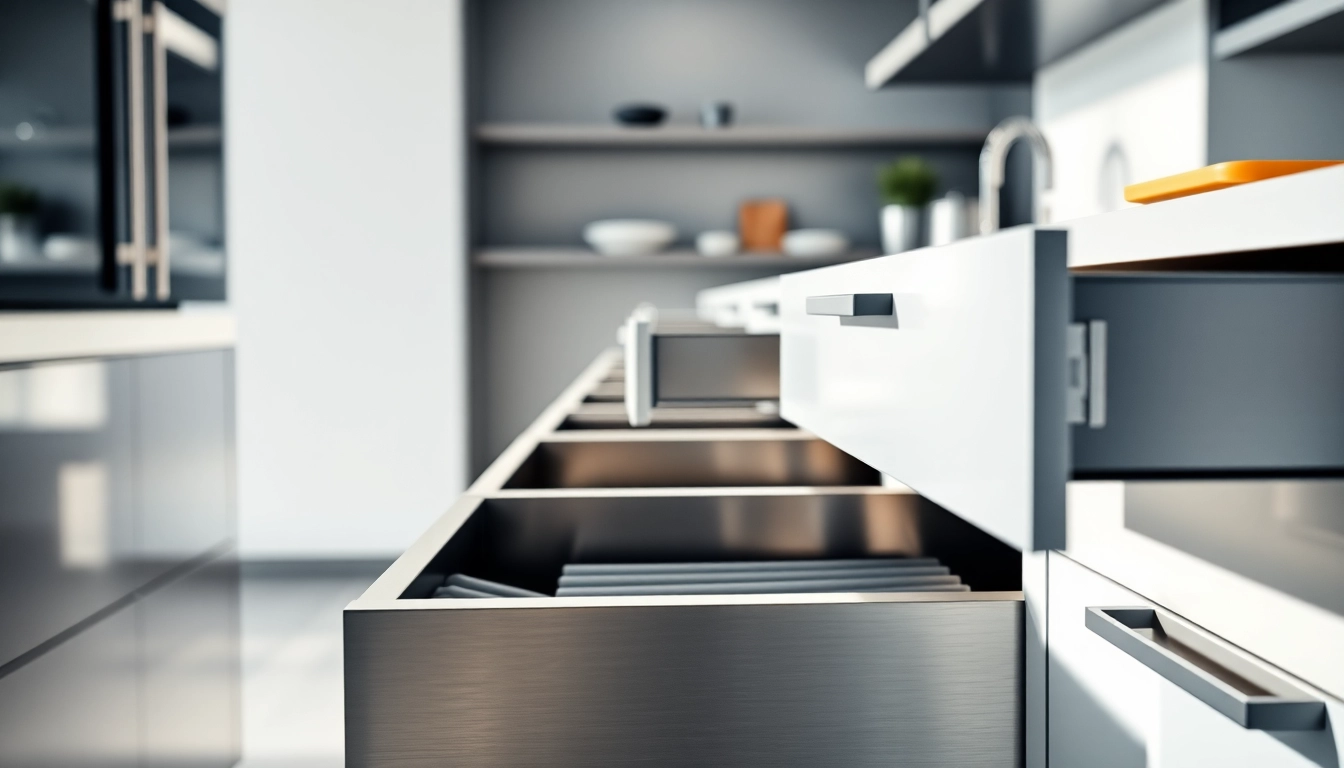Durability and Functionality: The Essential Guide to Metal Drawer Systems
Understanding the Metal Drawer System
Metal drawer systems have gained popularity in both residential and commercial settings due to their robust construction and sleek appearance. As an integral part of any cabinetry, these systems offer durability and functionality that cater to various storage needs. From the kitchen to the office, understanding the components and benefits of a Metal Drawer System is crucial for making informed decisions in your cabinetry design and organization.
What is a Metal Drawer System?
A metal drawer system comprises various components designed to work in unison to create durable and functional storage solutions. Unlike traditional wooden drawers, metal systems offer a modern aesthetic while providing increased strength and resistance to wear and tear. These systems often include metal drawer boxes, slides, and a range of accessories that enhance their usability and longevity.
Components of a Metal Drawer System
The primary components of a metal drawer system typically include:
- Drawer Boxes: These are often made from high-quality steel, ensuring strength and stability. They come in various sizes and finishes to suit different styles and needs.
- Drawer Slides: Available in multiple configurations such as side-mount, under-mount, and ball-bearing types, these slides determine how the drawer opens and closes, impacting both function and ease of use.
- Drawer Accessories: Features like dividers, organizers, and soft-close mechanisms may also be included to enhance the usability and organization within the drawer.
Benefits of Choosing Metal Drawers
Choosing metal drawer systems comes with a variety of benefits that can significantly enhance your space.
- Durability: Metal drawers are often more resistant to bending, breaking, or damage compared to wood, making them ideal for heavy use in kitchens or workspaces.
- Ease of Maintenance: Unlike wood, which may stain or warp, metal surfaces can be efficiently cleaned, maintaining their appearance and functionality over time.
- Design Versatility: Available in various colors and finishes, metal drawer systems can be customized to fit any décor, from modern to classic.
Types of Metal Drawer Systems
When selecting a metal drawer system, it’s essential to understand the different types available, as each has unique features suited for specific applications.
Standard vs. Heavy-Duty Metal Drawers
Metal drawers are classified into standard and heavy-duty categories. Standard drawers are suitable for regular storage needs, while heavy-duty options are designed to bear heavier loads, making them ideal for industrial or commercial applications. Heavy-duty drawers often feature reinforced construction and are engineered to handle significantly more weight and frequent use.
Under-Mount vs. Side-Mount Systems
Drawer slide configurations are another critical consideration:
- Under-Mount Slides: These provide a sleek, clean look as they are hidden from view. They generally allow for a full-range of motion and contribute to smooth, quiet operation.
- Side-Mount Slides: These are more visible but offer strong support and stability. They may require more clearance to function properly, so space considerations are necessary when selecting this type.
Soft-Close Features and Advantages
Many modern metal drawer systems include soft-close mechanisms, which gently guide the drawer shut, preventing slamming and wear over time. This feature significantly enhances user experience, particularly in environments where noise reduction is essential, such as in shared living spaces or busy kitchens.
Choosing the Right Metal Drawer System for Your Needs
Selecting the correct metal drawer system requires careful consideration of several factors to ensure that the final choice meets both functional and aesthetic requirements.
Assessing Your Storage Requirements
Start by analyzing what you need the drawer system for. Will it hold light kitchen utensils or heavy workshop tools? Understanding your storage requirements will dictate the type of metal drawer system you should choose, including the size and load capacity.
Style and Aesthetic Considerations
The visual appeal of metal drawer systems should not be overlooked. Consider how the chosen color, finish, and style will integrate with your existing décor. Opt for finishes that complement your cabinetry and overall design theme, whether you prefer a polished chrome look or a matte black finish.
Budgeting for Metal Drawer Systems
Investing in metal drawer systems can vary in cost. Planning a budget in advance will guide you toward the options that best fit your financial constraints. Compare features and benefits among various brands while considering long-term durability, as investing in higher-quality systems may save money over time through lower replacement costs.
Installation Guide for Metal Drawer Systems
Installing a metal drawer system can be a straightforward process if you follow the appropriate steps and prepare adequately.
Tools and Materials Needed
Before starting, gather necessary tools which may include:
- Power drill
- Screwdriver
- Measuring tape
- Level
- Safety glasses
- Stud finder
Step-by-Step Installation Process
The installation process can be broken down into the following steps:
- Measure the cabinet space where the drawer will be installed to ensure a proper fit.
- Install the metal drawer slides according to the manufacturer’s instructions, ensuring they are level and aligned correctly.
- Attach the drawer box to the slides, confirming smooth operation before securing it fully.
- Double-check the installation by opening and closing the drawer multiple times to ensure everything functions smoothly.
Common Installation Mistakes to Avoid
To ensure a successful installation, avoid these common pitfalls:
- Inaccurate Measurements: Always double-check your cabinet dimensions against your drawer system size.
- Incorrect Slide Placement: Ensure drawer slides are installed at the correct height and securely attached to avoid malfunctioning.
Maintenance and Care for Metal Drawer Systems
Proper maintenance is essential to ensure the longevity and optimal functionality of your metal drawer systems.
Regular Cleaning and Upkeep
Routine cleaning should involve wiping down the metal surface with mild soap and water to prevent grime from building up. Check the slides periodically for dust or debris that could hinder movement.
Identifying and Resolving Common Issues
Common problems include misalignment or sticking drawers. If you encounter these issues, check the installation and adjust the slides accordingly. Lubricating the slides can also help maintain smooth operation.
Longevity Tips for Metal Drawers
To extend the life of your metal drawer systems, consider these tips:
- Limit the weight placed in each drawer to prevent strain on the slides and structure.
- Regularly inspect the drawer for loose screws and fix them as needed.



